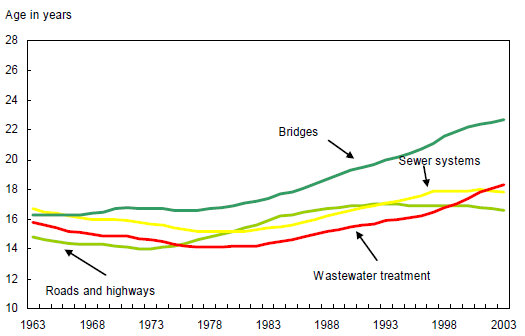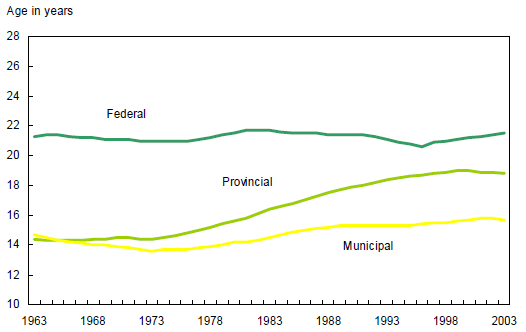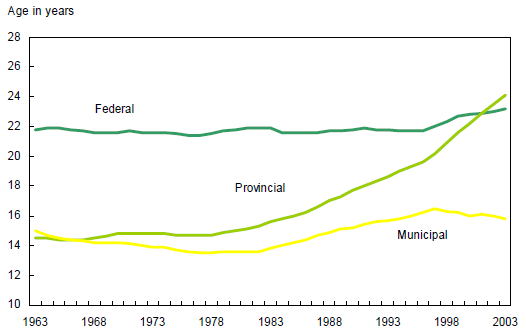Common menu bar links
The Age of Public Infrastructure in Canada
Archived Content
Information identified as archived is provided for reference, research or recordkeeping purposes. It is not subject to the Government of Canada Web Standards and has not been altered or updated since it was archived. Please "contact us" to request a format other than those available.
by Valérie Gaudreault and Patrick Lemire,
Investment and Capital Stock Division

Summary
First decline in average age in 30 years
Urbanization and population growth
Road network: Recent decline in age
Road infrastructure has shifted to municipalities
Sewer systems: Rejuvenation of municipal infrastructure
Sewer systems: Fastest rate of growth in value
Wastewater treatment facilities: Oldest infrastructure
Bridges: Youngest infrastructure relative to its useful life
Most investment has been in new construction
Summary
Nothing lasts forever, especially if it’s a road or a bridge or a sewer system. Potholes and bursting water pipes in the winter remind us of the importance of infrastructure for our quality of life. At the same time, governments face increased pressure for new infrastructure, or to repair the old.
In recent years, the state of Canada’s infrastructure has become a major issue for governments and the public. But is it improving, or not?
This study examines the aging of the four main components of engineering infrastructure, owned by governments, over the past 40 years: roads and highways, sewer systems,1 wastewater treatment facilities2 and bridges. Combined, they comprised 80% of all engineering infrastructures owned by federal, provincial, territorial and municipal governments in 2002.
The study supports, to some degree, the widely held view that Canada’s infrastructure has aged. However, the aging trend has stabilized in recent years. In 2003, average age actually diminished slightly, thanks to recent increases in investment by the various levels of government.
The steady pace of urbanization and population growth, among other factors, has necessitated huge amounts of investment, particularly for roads and sewers. This addition of new infrastructures contributed to stabilize the average age.
The study found that in 2003, three of the four components had passed the halfway mark of their so-called “service life”, for all levels of government.
Wastewater treatment facilities, the oldest infrastructure, had 63% of their useful life behind them in 2003. Bridges, the youngest infrastructure, had reached 49% of their useful life. Roads and highways had reached 59%, and sewer systems 52%.
This stock of government-owned engineering infrastructure is huge, worth an estimated $154.8 billion in 20023. It has a tangible impact on the economic performance of Canadian businesses, let alone the pleasure of driving on good roads and bridges.
During the past 40 years, growth in infrastructure has accounted for just under one-fifth of productivity gains in the business sector, a measure of the efficiency with which inputs are used to produce goods and services.4
Key concepts
Public engineering infrastructure
For the purpose of this paper, we define public engineering infrastructure as consisting of the following four main components: roads and highways, sewer systems, wastewater treatment facilities, and bridges owned by governments.
Investment in infrastructure represents spending on assets to be used in the production process. Such assets generally have a service life of more than one year and include new fixed capital formation and investment in replacement assets.
Service life and mortality function
The service life of an asset is its productive life, that is, the length of its useful life at the time of its acquisition. For example, an asphalt roadway—whether it is a road or highway—has a mean service life of 28 years. The service life is an average based on data from the Capital and Repair Expenditure Survey. The survey also provides data on the age-price profiles of discarded assets.
The mortality function reflects the retirement (decommissioning) of assets from capital stock when the assets reach the end of their useful life. The function used for asset retirement is represented by a normal distribution truncated at the tails. The distribution reflects service life variation due to asset quality and maintenance. Assets may be retired for various reasons. They can be exported, sold for scrap, dismantled, demolished or simply abandoned. For the four types of assets discussed in this article, service life generally ends in demolition.
For more information on how Statistics Canada computes the service life, mortality function and asset age, please see Investment Flows and Capital Stocks—Methodology 2001, Statistics Canada, internal document
Average age of capital stock
For analytical purposes, economists use a complex formula to estimate the age of public assets such as roads and bridges. The key factor is the amount of investment in public infrastructure. Without sufficient investment, the stock of infrastructure declines and ages. The more the investment, the younger the stock.
More precisely, the variables used to compute the average age of capital stock are the investment, the survival function, the year in which the investment was made, and year-end gross capital stock. In practice, there can be several different types of distributions for a given average age. For example, there can be structures whose ages are clustered around the average age, or a combination of young structures with much older structures.
Ultimately, this method of computing average age is for analytical purposes.
First decline in average age in 30 years
Overall, the average age of the four main components of engineering infrastructure considered in this study—roads and highways, sewer systems, wastewater treatment facilities and bridges—increased substantially between 1973 and 1999. Then their average age stayed stable until 2002, before declining slightly in 2003.
In 1973, on average the four components taken together were an estimated 14.7 years old. By 1999, this average had increased to 17.5 years, and stayed at that level until 2002. In 2003, it edged down to 17.4 years.
Most of the aging occurred between the mid-1970s and the late 1980s. In the following years, the aging continued, but at a slower pace.
Average age of the four types of infrastructure

Source: Statistics Canada, special tabulation, Investment and Capital Stock Division.
A key factor in the slower pace of aging recently is a huge jump in investment in roads and highways, which has tended to rejuvenate the transportation network.
The network has started getting “younger” as investment has risen. On the other hand, bridges and wastewater treatment facilities have been aging almost without interruption since 1977, while the age of sewer systems has fallen slightly since 2001.
Average age of asset types

Source: Statistics Canada, special tabulation, Investment and Capital Stock Division.
Two out of three levels of government saw the age of their infrastructure, covered by this study, decline in 2003. Provincial and municipal infrastructure got younger, while the average age of federal infrastructure remained virtually unchanged. Nevertheless, federal infrastructure was already older than provincial and municipal infrastructure.
Provincial infrastructure, covered by this study, aged the most, its average rising from 14.4 years to 18.8 years between 1963 and 2003. The age of municipal infrastructure also increased, though to a lesser degree.
Average age of the four types of infrastructure, by level of government

Source: Statistics Canada, special tabulation, Investment and Capital Stock Division.
Importance of public engineering infrastructure in Canada
The stock of government-owned infrastructure is huge, worth an estimated $154.8 billion in 2002 (the figures in this text box are in current dollars). Combined, the stock of public engineering infrastructure of the four main components comprised 80% of all engineering infrastructures owned by governments in 2002.
The value of the four main components at the federal level was $4.3 billion in 2002, compared to $54.6 billion at the provincial level. More than half the value of the four main components ($65.0 billion) was at the municipal level.
Urbanization and population growth
There are many factors contributing to investment in infrastructure: population growth, urbanisation, urban sprawl, standard of living and car usage.5
The strong population growth in urban areas has probably been a primary factor in shaping major changes in infrastructure. It undoubtedly accounts, in part, for the higher growth in the discussed components of infrastructure and the expanding role of municipal governments.
Urban growth goes hand in hand with the need for infrastructure. As the municipality grows, the need for infrastructure grows.
The average age of municipal infrastructure is a function of the development of new suburbs, which are made up of recent infrastructure, as well as the infrastructure in older neighbourhoods. The development of new suburbs may decrease the average age of the municipal infrastructure even if nothing is done to offset the aging of infrastructure in older parts of a city.
Table
Urban population of Canada.
Road network: Recent decline in age
The road network started getting younger in 1995, following a period of steady aging from 1974 to 1992. The high levels of investment have rejuvenated the road network. However, they have not been enough to bring the age of roads and highways down to what it was in the early 1960s.
The average age of roads and highways rose from 14.1 years in 1974 to 17.0 years in 1992 and then edged down to 16.6 years in 2003.
Because the average service life for roads and highways is 28 years, this means that by 2003, this network already had over 50% of its useful life behind it.
The road network is by far the largest component examined in this study, accounting for two-thirds of the total value. Between 1963 and 2003, the value of Canada’s network of government-owned roads and highways increased from $35 billion to $74 billion.6 Nevertheless, the network’s share of the four main components studied declined from 72% to 65% during the same period.
Over the 40 past years, the age of Canada’s roads and highways has increased at the municipal and provincial levels, and declined at the federal level. But in 2003, the average age dropped for the three levels of government.
Age of roads and highways, by level of government

Source: Statistics Canada, special tabulation, Investment and Capital Stock Division.
At the federal level, the age of the road network declined, although the federal network made up less than 3% of the total stock of roads and highways in 2003.
Provincial roads and highways aged the most, their average age climbing from 14.1 years in 1963 to 17.6 years in 2003.
Between 1963 and the early 1970s, strong growth in investment rejuvenated the provincial road network. However, subsequent investments were not enough to keep its average age at the level achieved in the mid-1970s. An upswing in investment in 1999 and subsequent years resulted in a decline in the network’s age starting in 2000.
The municipal road network is relatively younger and aged slightly over the 40-year period, reaching an average 15.0 years in 2003. Despite sustained growth up to the mid-1990s, investments were unable to keep pace with the aging of the road network. The average age of the municipal network has however been stable over the last 10 years.
Road infrastructure has shifted to municipalities
During the past 40 years, the road network’s stock of infrastructure has shifted from provincial governments to municipal governments. This occurred as the federal and provincial governments transferred responsibilities to municipal governments.
The value of municipal capital stocks rose 226% between 1963 and 2003 while for the same period the provincial capital stocks rose 79% and the federal capital stocks decline 42%.
As a result, the municipal share of the capital stock for roads and highways rose by 16 percentage points between 1963 and 2003, while the provincial share fell by 10 percentage points and the federal share fell by 6 points.
Investment in roads and highways, by level of government

Source: Statistics Canada, special tabulation, Investment and Capital Stock Division.
The largest investment item of the four infrastructure components was the road network, for each of the three levels of government during the period.
The investments made over the last 10 years were 10% higher than the investments made between 1964 and 1973.
The high levels of investment have rejuvenated the road network. However, they have not been enough to bring the age of roads and highways down to what it was in the early 1960s.
Provincial governments contributed the largest portion of road infrastructure investment until the early 1990s, when municipal governments caught up.
Sewer systems: Rejuvenation of municipal infrastructure
Municipal sewer systems have been getting younger since 1997, as municipalities have been investing heavily in this type of infrastructure. Between 1997 and 2003, municipal governments accounted for more than 95% of the total investment.
In 2003, municipal systems had reached only 47% of their useful life. In contrast, provincial sewer systems had reached 71% of their useful life, and federal systems, 68%.
The provincial sewer system was 24.1 years old in 2003 and the federal system 23.2 years old. However, those levels of government owned less than 20% of the total sewer system stock.
At the municipal level, the situation was much different. Sewer systems were only 15.8 years old in 2003. Investments made by municipal governments in the late 1990s have rejuvenated the system.
It is this huge investment by municipal governments that has kept their sewer systems relatively young. Provincial and federal sewer infrastructures are much older than municipal.
Age of sewer systems, by level of government

Source: Statistics Canada, special tabulation, Investment and Capital Stock Division.
Sewer systems: Fastest rate of growth in value
Canada’s sewer system stock has grown at the fastest pace of all four components. The value of the national sewer system has more than tripled in the last four decades, climbing from $5.8 billion in 1963 to $18.5 billion in 2003.
In fact, the sewer system has expanded along with the road network. Municipal stock, the largest in value, has experienced the fastest growth. Between 1963 and 2003, the municipal share of total stock jumped from 50% to 81%.
The sewer system also experienced the highest growth in investment, and this is the reason that the age of the system has remained steady over the years.
Between 1963 and 2003, investment in sewer systems more than doubled (+156%) because of urbanisation and population growth. Average annual investment rose from $580 million between 1964 and 1973 to $1 billion between 1994 and 2003.
As a result, investment in sewer infrastructure accounted for 18% of total investment in the four components in 2003, well above its 12% share in 1963.
Wastewater treatment facilities: Oldest infrastructure
Of all four components, wastewater treatment facilities were closest to the end of their service life. The average age of treatment facilities was 18.3 years in 2003, which represented 63% of their estimated service life of 29 years.
Municipal governments were responsible for more than 70% of the stock and accounted for more than 95% of total investment between 1997 and 2003. The age of municipal facilities rose from 14.4 years in 1963 to 16.9 years in 2003. This aging had a substantial impact on the age of the total stock of treatment facilities.
By 2003, municipal wastewater treatment facilities had reached 58% of their useful lives, compared with 71% at the federal level and 76% at the provincial level.
The age of federal wastewater treatment facilities declined during the 40-year period, edging down from 21.1 years in 1963 to 20.7 years in 2003. However, this decline had little effect, since the federal government was responsible for just 6% of the wastewater treatment facility stock in 2002.
In contrast, the age of provincial facilities ballooned from 14.2 years to 22.1 years during this 40-year period. The provinces accounted for 18% of the wastewater facility stock in 2002.
In fact, a significant portion of the provincial facilities are very close to the end of their 29-year service life. The stock aged more rapidly between 1983 and 2003, and its age has been affected by declining investments by provincial governments since 1987.
In 2002, wastewater treatment facilities made up 10% of the total for the four components this study considered. The value of wastewater treatment facility stock increased steadily between 1963 and 1995 and then began to fall. Both municipal and provincial governments have seen their wastewater treatment facility stocks shrink in recent years.7
Overall, there was significant investment in wastewater treatment facilities up to the mid-1990s. Subsequently, investment dropped to levels below those recorded in the early 1960s. The investments made by provincial and municipal governments probably included some capacity to meet future requirements, which would explain the recent decline.
Age of wastewater treatment facilities, by level of government

Source: Statistics Canada, special tabulation, Investment and Capital Stock Division.
Bridges: Youngest infrastructure relative to its useful life
Bridges were the youngest of the four infrastructure components relative to their useful life in 2003. They had reached only 49% of their useful life, with an average age of 22.7 years over a service life of 46 years.
By 2003, federal and provincial bridges had passed past the halfway mark of their useful lives; 57% in the case of federal bridges and 53% in the case of provincial. In contrast, municipal bridges were younger, and had only 41% of their useful lives behind them.
Provincial bridges were primarily responsible for the aging of the total stock. Very low levels of investment by provincial governments had a direct impact on the average age of bridges, which rose from 15.4 years to 24.6 years between 1963 and 2003. Provincial bridges made up 57% of total bridge infrastructure in 2003.
Federal bridges were 26.4 years old in 2003, but they accounted for only 3% of the total stock. Municipal bridges were 19.0 years old and made up 39% of bridge infrastructure that year.
Between 2000 and 2003 bridge stock grew more slowly because of lower investment in the late 1990s. Nevertheless, the value of bridge stock tripled between 1963 and 1993 (from $3.3 billion to $9.3 billion).
Overall, the municipal share of investments increased steadily from the 1960s to the end of the period under study.
Provincial investments plateaued in the mid-1970s and then declined. They went from $181 million in 1963 to $169 million in 2003. Over the entire period from 1963 to 2003, the lowest level was recorded in 2000.
Age of bridges, by level of government

Source: Statistics Canada, special tabulation, Investment and Capital Stock Division.
Most investment has been in new construction
One of the major challenges associated with infrastructure is setting aside enough money for maintaining and renovating existing infrastructure. Deterioration of infrastructure has a direct impact on national wealth, negatively affecting the country’s development and the quality of life of its residents.
In addition, when maintenance and renovations are postponed, the direct effect is a reduction in the asset’s service life. Another consequence is a loss of productivity.8
Maintenance and renovations are required not only for more visible assets such as roads and bridges but also for less evident ones, such as sewer systems and wastewater treatment facilities.
Recent data are not available. However, data for the five-year period between 1992 and 1997 show that investments in construction of new infrastructure accounted for the lion’s share of total investment, 84%.9
Through analysis of the breakdown, it can be determined whether the investment is used to renovate existing structures or to create new assets.
Table
Average breakdown of investment between new construction and renovations, 1992-1997, by level of government.
Except for municipal wastewater treatment facilities and provincial bridges, the share of new construction for all the asset types concerned at the municipal and provincial levels was close to the 84% average. With regard to municipal wastewater treatment facilities, there was a large volume of new construction during the six-year period. For provincial bridges, the breakdown indicates that there was some new construction, but a much larger number of renovations than for the other two levels of government.
Definitions and data sources
Capital stock
Capital stocks are reproducible tangible assets that are used as factors of production in combination with other factor inputs such as labour, energy and other natural resources or materials. The stock of capital consists of building construction (such as plants and offices), engineering construction (such as dams) and machinery and equipment used in the production process. They are distinguished from non-reproducible assets such as land, mineral deposits and natural resources, which are not produced but are directly incorporated in the production of other commodities.
Investment
Investment data measure the additions to capital stock during a particular period. The investment data are provided by the Capital and Repair Expenditures Survey, which collects a wealth of detail on capital expenditures. Respondents are asked to report their expenditures on over 50 types of machinery and equipment assets and over 90 types of construction assets.
Data sources
Engineering infrastructure statistics are derived primarily from Investment and Capital Stock Division’s (ICSD’s) Capital and Repair Expenditures Survey. The average age of capital stock is compiled by ICSD’s National Wealth and Capital Stock Section. For more information on data, please see Private and public investment in Canada, revised intentions, Statistics Canada Catalogue no. 61-206-XIB.
Endnotes
- Sewer system include sanitary and storm sewers, trunk and collection lines, open storm ditches.
- Wastewater treatment facilities include sewage treatment and disposal plants (including pumping stations)
- This value is in current dollars. Capital stock and investment data in this article are generally in 1997 constant dollars.
- Formore information on how infrastructure affects productivity, please see T. M. Harchaoui, F. Tarkhani and P. Warren, “Public Infrastructure in Canada, 1961-2002,” Canadian Public Policy, vol. 30, no. 3, September 2004, pp. 313–318.
- It’s not the intent of this paper to analyze all factors behind infrastructure investment, rather to explore some of the key factors.
- Except when otherwise stated, all capital stock and investment data in this article are in 1997 constant dollars.
- Detailed capital stock tables are available from the authors (to request them, send an e-mail to analysisinbrief-analyseenbref@statcan.gc.ca).
- For more information on how infrastructure affects productivity, please see T. M. Harchaoui, F. Tarkhani and P. Warren, “Public Infrastructure in Canada, 1961-2002,” Canadian Public Policy, vol. 30, no. 3, September 2004, pp. 313–318.
- These data are the results of an additional question in the Capital and Repair Expenditures Survey between 1992 and 1997. This breakdown is based on an average of six years of data on the breakdown between new construction investment and renovation investment.

